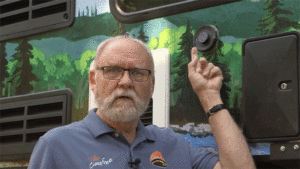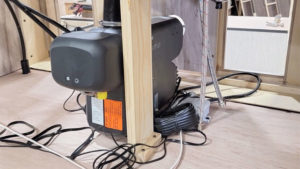rv Product review
Truma's new VarioHeat Furnace
I’m Jeff Johnston for “Rollin’ On TV.” When we started to spec out our new Palomino camper, filling out all the blanks on the ordering sheet, we knew that there were a few items we could improve on that normally come from the factory. Item number one on our list was the furnace. And in this case, the new Truma VarioHeat furnace is a high-tech alternative to the factory equipment. The only thing that gives you a clue on the outside that there’s something different going on is the combined air intake and exhaust port. And it’s made out of plastic; part of it is, anyway. And the reason they can do that is because it’s a testimony to the VarioHeat’s efficiency. Most of the heat is going inside the living space where it belongs; very little of the combustion heat is coming out through the exhaust.
 We met up with Truma’s Jonathan Ellis at the Truma headquarters and he told us what the VarioHeat was all about. Jonathan Ellis: Yeah, this is our compact furnace offering for the North American RV market. It’s 11,500 Btus and it’s propane-fired. Don’t let the Btus scare you away. It operates very similarly to about a 20,000 Btu furnace. Reason being, it is– it’s very efficient, so about 90% efficiency, and that 11,500 Btus, it’s not just our input Btus, it’s actually our output Btus. So we actually measure that a little bit differently than, you know, our competitor. Jeff: Okay, very cool, and I understand that it’s– the efficiency is what we expect out of a contemporary design product. It’s very efficient for electricity and propane use.
We met up with Truma’s Jonathan Ellis at the Truma headquarters and he told us what the VarioHeat was all about. Jonathan Ellis: Yeah, this is our compact furnace offering for the North American RV market. It’s 11,500 Btus and it’s propane-fired. Don’t let the Btus scare you away. It operates very similarly to about a 20,000 Btu furnace. Reason being, it is– it’s very efficient, so about 90% efficiency, and that 11,500 Btus, it’s not just our input Btus, it’s actually our output Btus. So we actually measure that a little bit differently than, you know, our competitor. Jeff: Okay, very cool, and I understand that it’s– the efficiency is what we expect out of a contemporary design product. It’s very efficient for electricity and propane use.
Jonathan: Yup, it is, yeah. So on propane usage, it’s around 90% efficient. You know, compare that to your typical North American RV furnace in the high 60s.
Jeff: This, as I understand, is a lot quieter and it has multi– different fan speeds instead of just one blow– one blowing speed.
Jonathan: Yup, yeah, so there’s three stages, there’s three operating levels for heating. And then there’s also an additional night mode. So when it’s in night mode, it’s actually going to maintain a very quiet level, and that’s generally used, you know, once you’re up to temperature and just to maintain, and it’s not gonna have any of those big, noisy, it’s firing up–
 It’s gonna be a nice consistent sound but also very quiet. Jeff: And one other item about this that matters is it’s really lightweight compared to– I don’t know what the other furnaces on the market weigh, but this is something that if weight is seriously a concern for a smaller vehicle, this is a great option.
It’s gonna be a nice consistent sound but also very quiet. Jeff: And one other item about this that matters is it’s really lightweight compared to– I don’t know what the other furnaces on the market weigh, but this is something that if weight is seriously a concern for a smaller vehicle, this is a great option.
Jeff: Truma’s senior development technologist, Mike Schicker, was on hand at the factory to help with the VarioHeat prototype installation in our Palomino. Space is tight in a truck camper, more so in a fold-down with minimal cabinet space, but they made it work with a clean, effective installation using just one interior heat vent.
Jeff: We’re at the Truma headquarters in Elkhart, Indiana. Behind me, the large white box is an environmental chamber. They can use this chamber for high- and low-temperature testing; high temperature for testing air-conditioning units in RVs, and they can fit a full 40-foot motor home in here; and low temperature for testing furnaces and so on. We’re gonna be pulling our truck and camper into the chamber. They’re drawing the temperature back down and we’re going to see how well the VarioHeat heats up the inside of the camper at a really low outside temperature. Now, we may be able to draw it down to freezing, maybe 20 degrees, something like that. We’re not gonna take it all the way down to the well-below-zero point that this chamber is capable of, but then most people aren’t gonna use a little camper like ours at well below zero. As soon as we get the unit in there, we get it down to some kind of cold soak, we’ll be able to get some figures and show you how well the VarioHeat works.
Jeff: We’re inside the environment chamber here at Truma, where we’re drawing the temperature down for the truck and camper. After it’s down to a certain point, we’ll go inside, fire up the VarioHeat, and take some measurements to see how long it takes to bring it up to a comfortable point.
Jeff: Wireless temperature and humidity monitors were positioned in several spots inside and outside the camper. Nick Dunning: All right, so the highlighted sensors here are the sensors we have inside the RV. They’re set up to take measurements once every minute, and they communicate wirelessly so we actually receive the signals every ten minutes and it’ll send all of the updated readings. So, right now, these sensors are reading about between 45 degrees and 47 degrees Fahrenheit. Okay, so after about 15 minutes, the temperature has risen to about 72 degrees Fahrenheit inside. It started out about 45 degrees Fahrenheit, so after 15 minutes, we’re seeing a delta in the temperature of about 27 degrees and, obviously, it’ll keep heating up as we run it longer.
Jeff: The temperature outdoors in the environmental test chamber is now down to about 32 degrees, approximately. Here inside the camper, the VarioHeat has been running for about 40 or 45 minutes and it’s anywhere between 75 to 80 degrees, approximately. That’s somewhat warmer than most people are gonna have the inside of their living space on a regular basis. But it just goes to show, it pulled it up from that freezing point fairly quickly. And it’s also fairly quiet and, right now, the VarioHeat runs on about three different heating or fan speed levels. Right now, it’s running at the highest speed. We kicked it up on the thermostat to be able to illustrate. This is as noisy it’s going to be. Usually, especially at night, in the night mode, when it runs a little bit slower and quieter, it’s not gonna be waking us up when we’re trying to sleep up here. Sounds pretty efficient. It feels good. It smells good in here, we don’t have any of that new furnace, you know, burning smell that you get in some vehicles or some furnaces when you first start ’em up. So we’d say the VarioHeat is a success and highly recommended.

